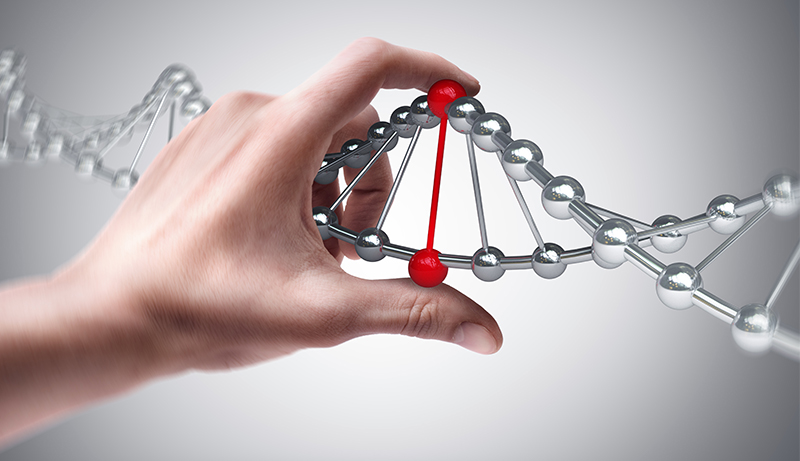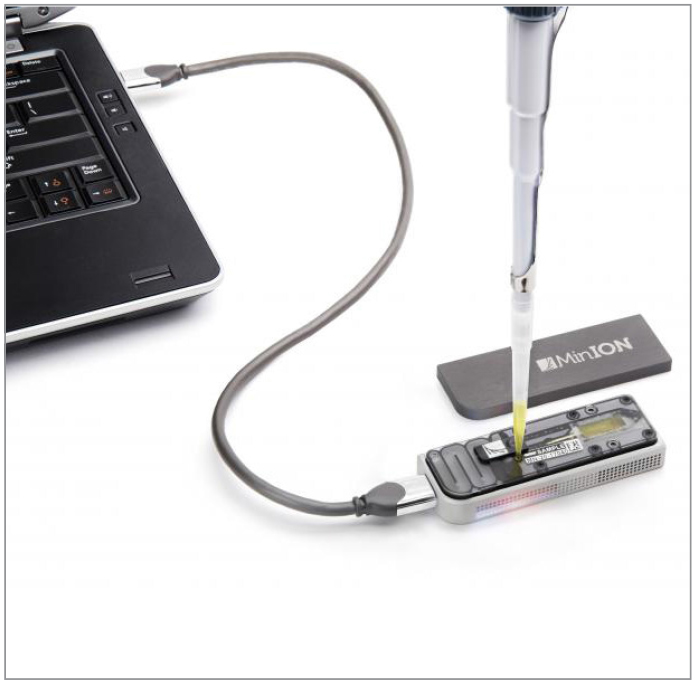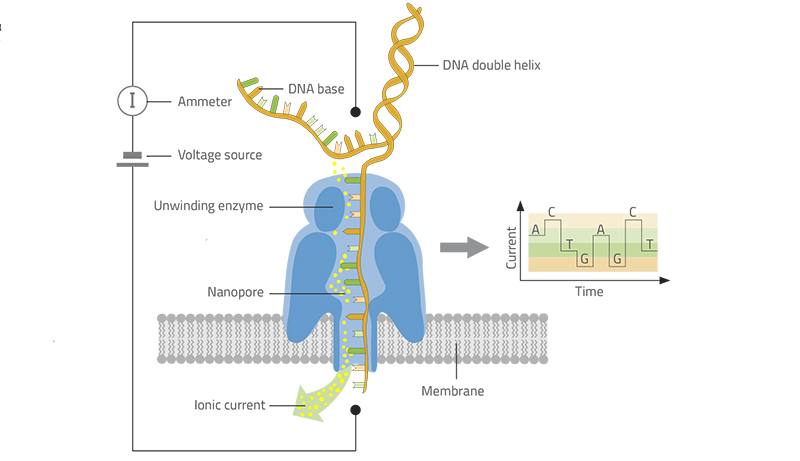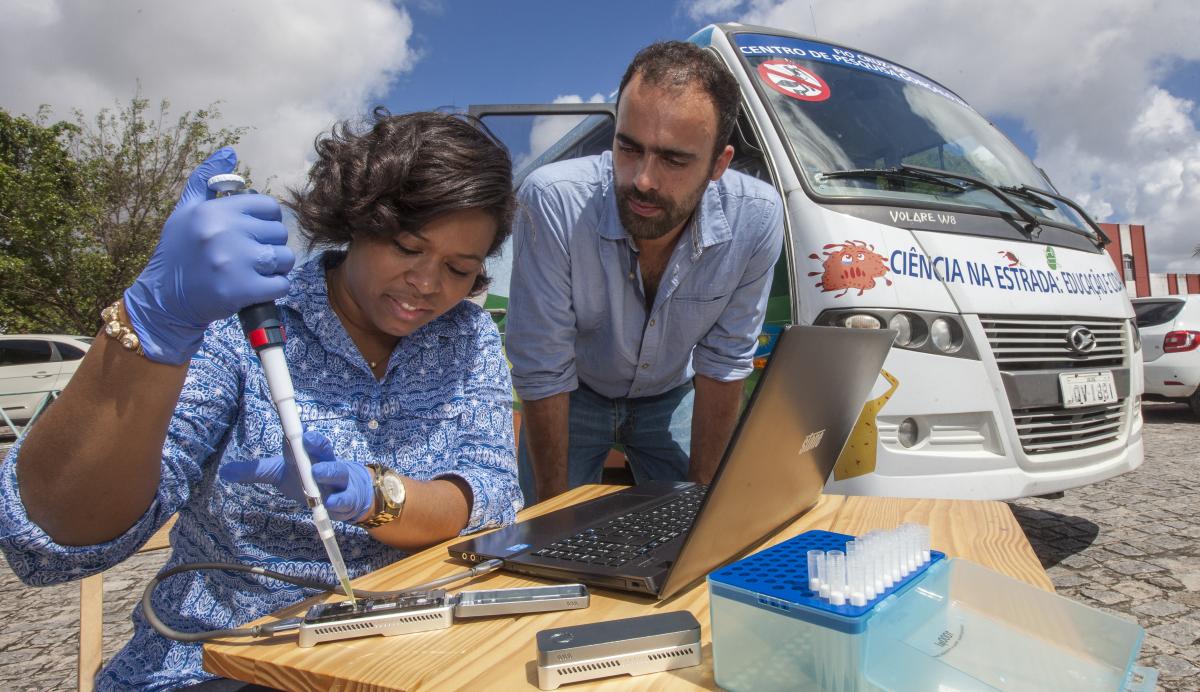Decoding DNA with a pocket-sized sequencer Understand article
USB-powered sequencers smaller than your smartphone could revolutionise the way we decode DNA – in hospitals, in remote locations and even in space.
What were the biggest technological developments of the 20th century? Computers may be the first thing that comes to mind: early computers for military and commercial use took up a whole room before they were transformed into smaller, affordable consumer products in the 1980s. Computing power has advanced at such a rate that the smartphones we use today can perform tasks that even the most powerful computers could not achieve decades ago. Now, another technology is being revolutionised in a similar way: the DNA sequencer.

Iaroslav Neliubov/Shutterstock.com
DNA stores the genetic information that is passed down between generations. Similar to the way computers store information as a string of zeros and ones, the information in DNA is stored as a code of four bases: A, T, C and G (adenine, thymine, cytosine and guanine).
In 2003, the first human genome – the complete set of genetic information – was sequenced. It took seven years, 150 scientists and 3 billion US dollars (2.5 billion euros) to complete the mammoth project. Today, the same task can be achieved in just over a day for around 1000 dollars (850 euros). What’s more, decoding the DNA doesn’t need to take place in a large-scale laboratory: it can be done with a portable sequencer that fits in your pocket. This remarkable reduction in cost and size is thanks to a new technique called nanopore sequencing.

sequencer connected to a
laptop via USB. The DNA
solution (yellow) is added
with a pipette.
Oxford Nanopore Technologies
How does nanopore sequencing work?
Portable DNA sequencers have been on the market since 2015. The sequencing process is straightforward and, unlike earlier methods of DNA sequencing, scientists do not need to make millions of extra copies of the DNA or to label the DNA with fluorescent or radioactive tags. First, the DNA is extracted – for example, from a swab or blood sample – and mixed with an ionic solution to prepare it for sequencing. This DNA liquid is then pipetted directly into the nanopore sequencer, which is plugged into a laptop via a standard USB cable (figure 1).
Inside the nanopore sequencer, an enzyme unwinds the DNA double helix and passes one of the strands through a nanopore – a microscopic channel in the centre of a protein molecule sited in a membrane. A voltage is applied across the nanopore, causing ions in the solution to move through the pore and generate an ionic current. The channel is just the right size for the DNA strand to pass through. Since each of the four DNA bases is different in size, it blocks a different proportion of the nanopore as it passes through. This means there is more or less space for ions to pass through the nanopore, and so more or less current can flow across the gap (figure 2). The ionic current is measured and the data is transferred to the computer and analysed by specialist software that converts the measurements in real time into the DNA sequence – a text file with the letters A, T, C and G.

Kerstin Göpfrich
Depending on how much DNA sequence data you want to generate, the sequencer can run for minutes or days. One way to analyse the data is to upload it to an online DNA database and compare it to known sequences. This way, you can find out which species the DNA belongs to, whether there were pathogens in the sample, and what genes are present. Nanopore sequencing is remarkably fast, but typically generates a smaller amount of data than other sequencing methods. Sequencing centres will therefore remain important for obtaining large amounts of data.
Applications of nanopore sequencing
Nanopore sequencers are opening up many new possibilities for DNA sequencing. They have already been used to identify viruses, bacteria and parasites in a hospital environment. Most notably, in 2015 a team of scientists took the first sequencing field kit to West Africa and sequenced blood samples from 142 patients during the Ebola outbreak to track the emergence of new strains (see Bryk, 2017). Scientists identified the viral DNA in each sample after just 15 minutes of sequencing, showcasing the potential of the new technology to monitor epidemics and to help identify drug and vaccine targets to instantly inform control measures. In the future, nanopore sequencing could also speed up the identification of cancers, which is particularly important for aggressive tumours; currently, it can take weeks from collecting a patient’s DNA sample to receiving the result from a laboratory.

University of Birmingham
Portable DNA sequencers have also been used to identify unknown species in remote areas, such as on high mountains and in the deep sea. Even further afield, it was announced at the start of 2018 that NASA astronauts had successfully identified microbes found on board the International Space Station using nanopore DNA sequencing. This means that astronauts could potentially diagnose infections using a sequencer to identify viral or bacterial DNA from their own mouth swabs. One day, nanopore sequencers may even be used to analyse DNA on other planets.
Using the same technology, DNA sequencing can now be carried out by students in the classroomw1 – for example, sequencing the DNA of fruits in a smoothiew2. While the cost of portable DNA sequencers may still be prohibitive for widespread use, this technology opens up many new opportunities for citizen science projects and education.
Ethics of DNA sequencing
Nanopore sequencing is the only technology to enable portable DNA sequencing of complete genomes. Currently, anyone can use a home genetic-testing kit for less than 150 euros. But unlike nanopore sequencing, which can provide a base-by-base result, these kits analyse only specific genes, and the results are sometimes questionable.
As whole-genome DNA sequencing becomes increasingly accessible due to nanopore sequencing, it will be crucial to consider the ethical questions. The more DNA we sequence, the better we will understand the health implications of genetic predispositions. But while genes may predict the probability of certain diseases, lifestyle factors often decide the outcome. Private companies are already marketing dubious ‘health horoscopes’ based on DNA testing – often neglecting the complexity and probabilistic nature of genomic data.
The data may also be misused for new kinds of discrimination. For example, will health insurance companies pick their customers depending on genetic profiles? Could DNA records be available to the police? In light of the sudden miniaturisation of DNA sequencers, in principle anyone could own such a device and sequence DNA as they choose – in fact, a smartphone DNA sequencer is already under developmentw3. We all leave traces of DNA everywhere we go, so privacy is now an increasing concern.
Like computers and smartphones, DNA sequencers have the power to change our lives – but we must work together across society to ensure that we maximise the opportunities, while also mitigating the risks of DNA sequencing.
References
- Byrk J (2017) Evolution in action: pathogens. Science in School 42: 8–13.
Web References
- w1 – For a podcast on DNA sequencing in the classroom involving both authors of this article, visit the Naked Scientists website.
- w2 – Learn more about an interactive DNA sequencing challenge set up by the authors, titled ‘DNA my smoothie’.
- w3 – Visit the Oxford Nanopore Technologies website to read about the latest DNA sequencer under development.
Resources
- Schedule a discussion between the authors and your students by making an appointment via the Ring-a-Scientist website – a project supported by Wikimedia Deutschland, Stifterverband and the Volkswagen Foundation within the Open Science Fellows Program. The authors can take you through sequencing experiments live via a video conference.
- To learn more about nanopore sequencing, visit the Oxford Nanopore Technologies website.
- For up-to-date information about the NASA project on DNA sequencing in space, visit the Oxford Nanopore Technologies blog, or listen to an interview with Dr Aaron Burton.
- The Wellcome Genome Campus provides detailed information, including classroom resources, about everything related to DNA.
Review
This interesting article addresses one of the main topics in biology: the DNA molecule. In particular, it focuses on a new technique that allows faster and cheaper sequencing of DNA using a powerful but small device.
This new tool, called nanopore sequencing, has the potential to open doors to a variety of applications. In the near feature, it could be as simple to use as smartphones are today. However, the ease with which the public’s DNA could be sequenced raises important ethical issues.
Together with images and graphics, the article could be used to explain the molecular biology techniques involved in reading and sequencing the DNA double helix, and how nanopore sequencing could replace earlier sequencing methods. It could also be used for discussions on the ethical issues and problems of privacy regarding genetic profiles.
Comprehension questions could include:
- Why does each nucleotide cause a different ionic signal in the nanopore sequencing device?
- What types of molecule could help to move the DNA through the nanopore?
- How does the DNA nanopore sequencer work?
- Explain two or three novel applications for the nanopore sequencer.
- What are the ethical issues surrounding the use of DNA sequencers?
Ana Molina, natural science teacher, IES Gil y Carrasco High School, Spain





